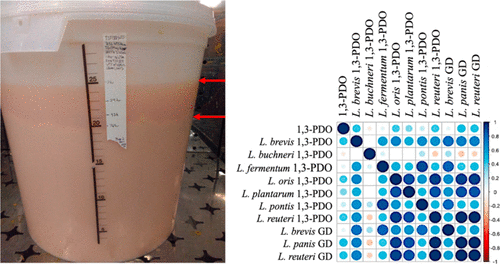当前位置:
X-MOL 学术
›
J. Agric. Food Chem.
›
论文详情
Our official English website, www.x-mol.net, welcomes your
feedback! (Note: you will need to create a separate account there.)
Changes in Bacterial Populations and Their Metabolism over 90 Sequential Cultures on Wheat-Based Thin Stillage.
Journal of Agricultural and Food Chemistry ( IF 5.7 ) Pub Date : 2020-03-06 , DOI: 10.1021/acs.jafc.9b07414 Timothy J Tse 1 , Jianheng Shen 1 , Youn Young Shim 1, 2, 3, 4 , Martin J T Reaney 1, 2, 3
Journal of Agricultural and Food Chemistry ( IF 5.7 ) Pub Date : 2020-03-06 , DOI: 10.1021/acs.jafc.9b07414 Timothy J Tse 1 , Jianheng Shen 1 , Youn Young Shim 1, 2, 3, 4 , Martin J T Reaney 1, 2, 3
Affiliation

|
Wheat-based thin stillage (W-TS) is a liquid co-product of wheat fermentation for ethanol production, which typically contains substantial amounts of glycerol. Two-stage fermentation, via endemic microorganisms, can be used in processes to convert this compound to more valuable products and simplify the enrichment process through the clarification of the medium and concentration of particles as a protein-rich concentrate. We recultured bacteria 90 times (72 h at 37 °C) on fresh W-TS to determine the stability of the culture and metabolic processes. Next-generation sequencing of W-TS revealed the presence of a predominant Lactobacillus community that rapidly displaced competing microorganisms (e.g., Pediococcus) in subsequent fermentations. These organisms produced bacteriocins (e.g., helveticin J, interpreted through the presence of bacteriocin genes) and acidified the fermentation broth (through the production of succinic acid: 1.7 g/L, lactic acid: 1.8 g/L, and acetic acid: 4.1 g/L). Furthermore, the microbial community produced cobalamin (inferred through sequencing) and converted glycerol (10 g/L reduced to 3.5 g/L after 72 h) to 1,3-propanediol (6.1 g/L after 72 h). Altogether, Lactobacilli were identified as the predominant endemic microorganisms in W-TS after the first 10 cultures. The community was stable and provided a novel approach to increase the value of organic solutes in W-TS.
中文翻译:

基于小麦的稀釜馏物上90种顺序培养物中细菌种群的变化及其代谢
小麦基稀釜馏物(W-TS)是小麦发酵中用于乙醇生产的液体副产品,通常含有大量的甘油。通过地方性微生物进行的两阶段发酵可用于将这种化合物转化为更有价值的产品的过程,并通过澄清培养基和浓缩为富蛋白质浓缩物的颗粒来简化富集过程。我们在新鲜的W-TS上将细菌再培养90次(在37°C下72 h),以确定培养和代谢过程的稳定性。W-TS的下一代测序揭示了主要的乳杆菌群落的存在,该群落在随后的发酵中迅速取代了竞争性微生物(例如小球菌)。这些生物产生了细菌素(例如helveticin J,通过存在细菌素基因来解释)并酸化发酵液(通过生产琥珀酸:1.7 g / L,乳酸:1.8 g / L和乙酸:4.1 g / L)。此外,微生物群落产生钴胺素(通过测序推断),并将甘油(72小时后10 g / L降至3.5 g / L)转化为1,3-丙二醇(72小时后6.1 g / L)。总的来说,在前10次培养后,乳杆菌被鉴定为W-TS中的主要地方性微生物。社区是稳定的,并提供了一种新颖的方法来增加W-TS中有机溶质的价值。微生物群落产生钴胺素(通过测序推断),并将甘油(72小时后10 g / L降至3.5 g / L)转化为1,3-丙二醇(72小时后6.1 g / L)。总的来说,在前10次培养后,乳杆菌被鉴定为W-TS中的主要地方性微生物。社区是稳定的,并提供了一种新颖的方法来增加W-TS中有机溶质的价值。微生物群落产生钴胺素(通过测序推断),并将甘油(72小时后10 g / L降至3.5 g / L)转化为1,3-丙二醇(72小时后6.1 g / L)。总的来说,在前10次培养后,乳杆菌被鉴定为W-TS中的主要地方性微生物。社区是稳定的,并提供了一种新颖的方法来增加W-TS中有机溶质的价值。
更新日期:2020-04-24
中文翻译:

基于小麦的稀釜馏物上90种顺序培养物中细菌种群的变化及其代谢
小麦基稀釜馏物(W-TS)是小麦发酵中用于乙醇生产的液体副产品,通常含有大量的甘油。通过地方性微生物进行的两阶段发酵可用于将这种化合物转化为更有价值的产品的过程,并通过澄清培养基和浓缩为富蛋白质浓缩物的颗粒来简化富集过程。我们在新鲜的W-TS上将细菌再培养90次(在37°C下72 h),以确定培养和代谢过程的稳定性。W-TS的下一代测序揭示了主要的乳杆菌群落的存在,该群落在随后的发酵中迅速取代了竞争性微生物(例如小球菌)。这些生物产生了细菌素(例如helveticin J,通过存在细菌素基因来解释)并酸化发酵液(通过生产琥珀酸:1.7 g / L,乳酸:1.8 g / L和乙酸:4.1 g / L)。此外,微生物群落产生钴胺素(通过测序推断),并将甘油(72小时后10 g / L降至3.5 g / L)转化为1,3-丙二醇(72小时后6.1 g / L)。总的来说,在前10次培养后,乳杆菌被鉴定为W-TS中的主要地方性微生物。社区是稳定的,并提供了一种新颖的方法来增加W-TS中有机溶质的价值。微生物群落产生钴胺素(通过测序推断),并将甘油(72小时后10 g / L降至3.5 g / L)转化为1,3-丙二醇(72小时后6.1 g / L)。总的来说,在前10次培养后,乳杆菌被鉴定为W-TS中的主要地方性微生物。社区是稳定的,并提供了一种新颖的方法来增加W-TS中有机溶质的价值。微生物群落产生钴胺素(通过测序推断),并将甘油(72小时后10 g / L降至3.5 g / L)转化为1,3-丙二醇(72小时后6.1 g / L)。总的来说,在前10次培养后,乳杆菌被鉴定为W-TS中的主要地方性微生物。社区是稳定的,并提供了一种新颖的方法来增加W-TS中有机溶质的价值。











































 京公网安备 11010802027423号
京公网安备 11010802027423号